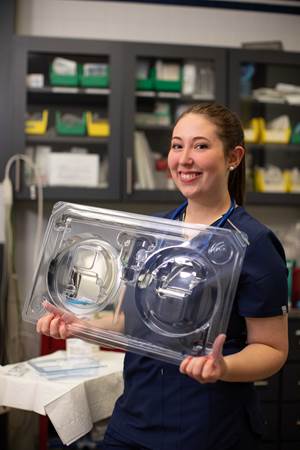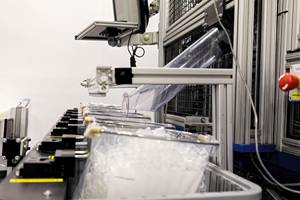Suppliers Team to Run Precision Teflon Tubing at Medical Show
Apart from the triennial K Show, extrusion system suppliers don’t operate lines at trade fairs that much anymore.


Apart from the triennial K Show, extrusion system suppliers don’t operate lines at trade fairs that much anymore.
But at last week’s MD&M West 2017 show in Anaheim, four suppliers teamed up to display a coextrusion line running a 1.4-mm diaTeflon fluoropolymer (FEP) catheter tube throughout the exhibit. Check out the video below to see the line in action.
The main body of the catheter was an FEP delivered by the primary 3/4-in. Davis Standard (D-S) extruder. A second D-S 3/4-in. extruder pumped equally spaced embedded white FEP stripes filled with barium sulfate for x-ray opacity.
The extruders showcased were part of D-S’ signature MEDD (Medical Extruder Direct Drive) machinery line. The MEDD extruder utilizes direct drive technology for more efficient operation as well as greater materials flexibility, a replaceable feed section liner, interchangeable barrel assembly and a Windows PLC control system.
To support its tubing customers, D-S has a medical lab line in a cleanroom environment at its Technical Center in Pawcatuck, Conn. This line features two MEDD extruders and associated downstream equipment located in a climate-controlled “clean room” environment. Customers are able to test new resins, make parts for proof-of-concept, and conduct downstream R&D prior to making large capital equipment investments. The line is said to be extremely versatile and set up to run multiple resins, with all components monitored and controlled by the EPIC III control system.
At the show, material streams were combined in a cross-head co-extrusion die supplied by Guill Tool & Engineering so that the barium-filled material forms four stripes that are embedded at 90° intervals around the circumference of the tube. Both the D-S extruders and die package featured streamlined designs to minimize residence time, owing to FEP’s tendency to burn.
From the die, the tube entered Conair’s MedVac vacuum-sizing/cooling tank. The vacuum creates pressure inside that tube that helps stabilize dimensions and prevent cooling water that might drool out of the tank’s feed opening from affecting the critical surface finish of the tube. An ultrasonic gauge inside the tank monitors the 0.4-mm wall thickness, while a Zumbach Electronics 3-axis OD laser gauge, positioned downstream from the tank, provides closed-loop dimensional control and displays the tube for concentricity adjustments. The data from these gauges are used to control puller speed and vacuum to maintain critical dimensions. A vision system is also incorporated into the line, detecting gels and surface imperfections and communicating with the quality mode to automatically separate good vs. bad tubes in-line.
The tubing then passes through a Conair MedLine puller/cutter. The puller portion of the unit consistently pulls the tubing down the line during sizing and cooling. The rotary-knife cutter slices the tube precisely to the specified length. Cut lengths were then carried away on a Conair medical takeaway belt conveyer. Once on the conveyor, cut pieces that don’t meet quality standards—based on the OD/ID gauge readings and the inline machine-vision—can be removed from the production stream with a puff of compressed air.
In fact, the MedLine puller/cutter has a scrap/QC mode that accepts all three inputs (from the wall-thickness gauge, the laser OD gauge and the cameras) and automatically sets a length offset so the cutter ‘knows’ when the defective piece will reach it. Then the cutter can be programmed either to cut tubing differently from good product or not cut at all, or it can change the way defective section is handled by the conveyor.
The line at MD&M also utilized several other pieces of equipment from Conair’s clean-room-ready MedLine product family. All MedLine products have been specially sized, configured, documented and supported for use in cleanrooms and other controlled environments. Each extruder was equipped with a Conair MicroWheel MW1-0.2 dryer. Featuring a 5.6-l (0.2 ft³) hopper, the dryer is said to be suited for processes that don't need the capacity of a large dryer and hopper, but still need the efficiency and reliability of Conair's desiccant-wheel drying technology. One of the dryers was fitted with a MedLine MiniLoader. This self-contained unit has its own vacuum motor to draw resin from machine-side storage. The straight through tube loader body ensures smooth flow, even with the small quantities typical of medical molding.
Two units in Conair’s new line of Thermolator temperature controls (TCUs) supplied temperature-conditioned water to the line. One TCU is used to match the extruder feed-throat temperature to ambient conditions so that condensation does not occur and degrade the pre-dried resin. The other TCU supplies tempered water to the sizing/cooling tank to control heat removal from the tubing.
Conair’s MedLine EP1A-03 portable air-cooled chiller provided chilled water to the TCUs. The chiller features an easy-to-clean RAL-9003-white painted housing, and nonferrous internal components (evaporator, pump, reservoir and piping) to resist corrosion. It has a compact footprint with easy-to-access interior, and a control that provides precise temperature control along with extensive diagnostics.
Related Content
Collaboration will bring Recycled Plastic to Medical Device Packaging
Agreement between Eastman and Ethicon will put copolyester derived from recycled materials in sterile barrier applications.
Read MoreAs Currier Grows in Medical Consumables, Blow Molding Is Its ‘Foot in the Door’
Currier Plastics has added substantial capacity recently in both injection and blow molding for medical/pharmaceutical products, including several machines to occupy a new, large clean room.
Read MoreMedical Manufacturer Innovates with Additive Manufacturing and Extrusion Technology Hubs
Spectrum Plastics Group offers customers two technology hubs — one for extrusion, the other for additive manufacturing — to help bring ground-breaking products to market faster.
Read MorePlastic Compounding Market to Outpace Metal & Alloy Market Growth
Study shows the plastic compounding process is being used to boost electrical properties and UV resistance while custom compounding is increasingly being used to achieve high-performance in plastic-based goods.
Read MoreRead Next
Why (and What) You Need to Dry
Other than polyolefins, almost every other polymer exhibits some level of polarity and therefore can absorb a certain amount of moisture from the atmosphere. Here’s a look at some of these materials, and what needs to be done to dry them.
Read MoreLead the Conversation, Change the Conversation
Coverage of single-use plastics can be both misleading and demoralizing. Here are 10 tips for changing the perception of the plastics industry at your company and in your community.
Read MoreHow Polymer Melts in Single-Screw Extruders
Understanding how polymer melts in a single-screw extruder could help you optimize your screw design to eliminate defect-causing solid polymer fragments.
Read More
















 (2).jpg;maxWidth=300;quality=90)









